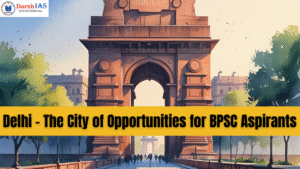Capital Outlay/ Capital Expenditure — expenditure by govt. (Central) on creating assets. [capital investment outlay for the third year in a row, by 33% to ₹ 10 lakh crore, which would be 3.3% of GDP and almost three times the outlay in 2019-20.]
Effective Capital Expenditure — The Grant-in-Aids to States are not counted in Capital Expenditure of the central govt. However some of the money from gant-in-Aids goes in creating assets. Effective Capital Expenditure counts the capital formation from Grant-in-Aids also.
Capital investment outlay for the third year in a row, by 33% to ₹ 10 lakh crore, which would be 3.3% of GDP and almost three times the outlay in 2019-20. However Effective capital outlay — 4.5% OF GDP.
Fiscal Deficit target — 5.9% of GDP.
- FRBM Act 2003, says to limit the Fiscal Deficit — to 3% of GDP by 2020-21.
- After the COVID, govt. modified the Act. Now the target is to limit the Fiscal deficit to 4.5% of GDP by 2025-26.
- Fiscal Deficit in 2020-21 — 9.2% of GDP; Govt. is targeting 6.4% as the Fiscal Deficit in 2022-23.
GDP Growth
- Real GDP growth in 2023-24 — 7% [Highest among major economies]
Part A of the Budget
India@100 — 100th year of Indian Independence [Amrit Kaal — 75th to 100th Years]: — target is Prosperous and inclusive India where the fruits of development reach all regions and citizens, especially our youth, women, farmers, OBCs, Scheduled Castes and Scheduled Tribes.
Resilience amidst multiple crises: — It means the resilience of Indian economy amidst many global problems like COVID, Russia-Ukraine war, etc.
G20 Presidency: Theme — Vasudhaiva Kutumbakam. It means “World is One Family.” This phrase is taken from Maha Upanishad. PM Modi has explained this Phrase as “One Earth One Family One Future”.
Achievements since 2014:
- Per capita income has more than doubled to 1.97 lakh. [Current Price]. Per capita income 2021-22: 1.50 lakh (current); 91,481 (real, 2011-12 price)
- From 10th largest economy to 5th largest.
- Formalisation of Economy: — as we know the informalisation of Indian Economy – that informal sector is increasing more than formal sector. However govt. says based on EPFO data, which has doubled to 27 crore — that formalisation has paced.
Vision for Amrit Kaal — an empowered and inclusive economy
- technology-driven and knowledge-based economy with strong public finances, and a robust financial sector and to achieve this, Jan Bhagidari through Sabka Saath Sabka Prayas is essential.
- 3 focus — facilitating ample opportunities for citizens, especially the youth, to fulfill their aspirations, secondly, providing strong impetus to growth and job creation and finally to strengthen macro-economic stability.
Four Opportunities can be transformative during Amrit Kaal
- Economic empowerment of Women — under Deendayal Antyodaya Yojana National Rural Livelihood Mission (a poverty alleviation project, launched in 2011) — 81 lakh Self Help Groups. Govt. will help them by forming large producer enterprises or collectives (large member and professionally managed). — means a producer organisation will be setup by these SHGs through govt’s help. A Producer Organisation (PO) is a legal entity formed by primary producers, viz. farmers, milk producers, fishermen, weavers, rural artisans, craftsmen. A PO can be a producer company, a cooperative society or any other legal form which provides for sharing of profits/benefits among the members.
- PM VIshwakarma KAushal Samman (PM VIKAS): — traditional artisans and craftspeople, who work with their hands using tools. These people are referred as Vishwakarma. Through financial support, skill training, digital technology, brand promotion, linkage with local and global markets, digital payments etc. Govt will integrate them with MSME value chain.
- Tourism:
- Green Growth: — green fuel, green energy, green farming, green mobility, green buildings, and green equipment. Development and opportunity in these field will provide green job opportunity.
Priorities of this Budget:[7] — all these 7 complement each other and acts as Saptrishi guiding us through Amrit Kaal.
- Inclusive Development
- Reaching the Last Mile
- Infrastructure and Investment
- Unleashing the Potential
- Green Growth
- Youth Power
- Financial Sector
Inclusive Growth — [Sabka Saath Sabka Vikas]: farmers, women, youth, OBCs, Scheduled Castes, Scheduled Tribes, divyangjan and economically weaker sections, and overall priority for the underprivileged (vanchiton ko variyata)
Agriculture
- Digital Public infrastructure for agriculture — information service for crop planning and health, farm credit, insurance, market access, agri-tech startups.
- Agriculture Accelerator Fund for Agri startups.
- Atmanirbhar Horticulture Clean Plant Programme — for high value horticultural crops. E.g. — fruits, vegetables, flowers, aromatic plants and herbs.
- Global Hub for Millets: ‘Shree Anna’: — Millet consumption will help in further nutrition (reduction in malnutrition), food security and welfare of farmers. How? India is largest producer and second largest exporter of ‘Shree Anna’ in world. E.g. of Millet — jowar, ragi, bajra, kuttu, ramdana, kangni, kutki, kodo, cheena, and sama.
Govt. will make India as the global hub for Millet. For this Indian Institute of Millet Research, Hyderabad to be made Centre of Excellence.
- Agriculture credit — 20 Lakh crore for animal Husbandry, diary and fisheries.
Health, Education and Skilling
- New Nursing college (157) in co-location in 157 medical college established since 2014.
To eliminate Sickle Cell Anaemia by 2017.
Sickle cell anemia is one of a group of inherited disorders known as sickle cell disease. It affects the shape of red blood cells, which carry oxygen to all parts of the body.
Red blood cells are usually round and flexible, so they move easily through blood vessels. In sickle cell anemia, some red blood cells are shaped like sickles or crescent moons. These sickle cells also become rigid and sticky, which can slow or block blood flow.
Although, no cure available, but pain relief medication can help. It is one of major cause of Anaemia in India. [low oxygen level in women due to ineffective or less number of Red Blood Cell].
- ICMR labs will be made available for research by public and private medical college and organisations.
- Health expenditure in FY 2023 — 2.1% of GDP. US – 24%; France- 11%; UK-10%; Brazil-9.6%; South Africa-9.1%; China-5.35%; Nepal-4.45%]
Teacher’s Training — District Institutes of Education and Training.
- Educational Expenditure in FY 23 — 2.9%
- National Digital Library for Children and Adolescents — for facilitating quality books across languages
Reaching the Last Mile
- Aspirational District Programme — already running. Launched in January 2018. aims to quickly and effectively transform 112 most under-developed districts across 27 states of the country.
- Monthly ranking based on incremental progress across 49 key Performance Indicators under 5 themes (weightage) — Health & Nutrition (30), Education (30), Agriculture & Water Resources (20), Financial Inclusion (10) & Skill Development and Infrastructure (10).
- Ranking done by Niti Aayog. Available on portal — “Champions of Change”
- Vision is to improve India’s ranking under the Human Development Index (HDI)
- Delta Ranking (Monthly) Nov 2022 — Lohardaga (JH), Jaisalmer (RJ), Hazaribagh (JH) … Virudhunaga (TN), Narayanpur (CG), Visisha (MP).
- Aspirational Blocks Programme — 500 blocks to be ranked across multiple domains such as health, nutrition, education, agriculture, water resources, financial inclusion, skill development and basic infrastructure.
- Across 31 states and UTs. Half of these blocks are in 6 states — Uttar Pradesh (68 blocks), Bihar (61), Madhya Pradesh (42), Jharkhand (34), Odisha (29) and West Bengal (29).
- Niti Aayog in partnership with states. Quarterly basis.
- For Particularly vulnerable tribal groups (PVTGs), — Pradhan Mantri PVTG Development Mission will be launched. — to provide basic facilities to PVTG such as safe housing, clean drinking water and sanitation, improved access to education, health and nutrition, road and telecom connectivity, and sustainable livelihood opportunities.
- Budget — 15,000 crore in 3 years.
- Eklavya Model Residential Schools — will be improved.
- Water for Drought Prone Region — Upper Bhadra Project in Karnataka.
Upper Bhadra Project envisages lifting of 17.40 Thousand Million Cubic Feet (TMC) of water from river Thunga to Bhadra reservoir and 29.90 TMC from Bhadra reservoir for utilization in Upper Bhadra Project. River Thunga is tributary of Krishna.
- ‘Bharat Shared Repository of Inscriptions’ will be set up in a digital epigraphy museum, with digitization of one lakh ancient inscriptions in the first stage.
Infrastructure and Investment: [This sector has large money multiplier. ]
- The capital outlay and effective expenditure — already discussed.
- Urban Infrastructure Development Fund (UIDF) will be established through use of priority sector lending shortfall, which will be managed by the National Housing Bank, and will be used by public agencies to create urban infrastructure in Tier 2 and Tier 3 cities.
Unleashing the Potential
- To enhance ease of doing business.
- Centre of excellence for Artificial Intelligence — vision of “Make A-I in India and Make A-I work for India”, three centers of excellence for Artificial Intelligence will be set-up in top educational institutions.
- National Data Governance Policy will be brought out to enable access to anonymized data.
Green Growth
- “LiFE”, or Lifestyle for Environment, to spur a movement of environmentally conscious lifestyle.
- India aiming for ‘panchamrit’ and net-zero carbon emission by 2070 to usher in green industrial and economic transition.
- National Green Hydrogen Mission, with an outlay of Rs 19,700 crores, will facilitate transition of the economy to low carbon intensity, reduce dependence on fossil fuel imports, and make the country assume technology and market leadership in this sunrise sector. The target is to reach an annual production of 5 MMT by 2030.
- Hydrogen Fuel — Hydrogen-powered fuel cell electric vehicles emit none of these harmful substances—only water (H2O) and warm air.
- However making Hydrogen is not easy and also costly. Technology innovation is reducing the price in this field.
- GOBARdhan scheme: — 500 new ‘waste to wealth’ plants under GOBARdhan (Galvanizing Organic Bio-Agro Resources Dhan) scheme.
- Waste to wealth plants will promote Circular Economy.
- In a circular economy, manufacturers design products to be reusable
- Bhartiya Prakritik Kheti Bio-Input Resource Centres — to promote natural farming.
Youth Power
- Defined youth as Amrit Peedhi.
- National Education Policy — benefits for Youth.
- Pradhan Mantri Kaushal Vikas Yojana 4.0 — it will further extend the programme for 3 years. The scheme will also include courses for Industry 4.0 like coding, AI, robotics, mechatronics, IOT, 3D printing, drones, and soft skills.
Industry 4.0 is revolutionizing the way companies manufacture, improve and distribute their products. Manufacturers are integrating new technologies, including Internet of Things (IoT), cloud computing and analytics, and AI and machine learning into their production facilities and throughout their operations.
- Unity Mall in state capital and important towns — to promote One District One Product (ODOP), GI products and other handicraft products.
Financial Sector
- Further financing MSME.
- National Financial Information Registry will be set up to serve as the central repository of financial and ancillary information.
- a one-time new small savings scheme, Mahila Samman Savings Certificate, will be made available for a two-year period up to March 2025. This will offer deposit facility upto Rs 2 lakh in the name of women or girls for a tenor of 2 years at fixed interest rate of 7.5 per cent with partial withdrawal option.
- the maximum deposit limit for Monthly Income Account Scheme will be enhanced from Rs 4.5 lakh to Rs 9 lakh for single account and from Rs 9 lakh to Rs 15 lakh for joint account. — Maximum Deposit Limit is the insurance on bank deposits of people. {applicable on all commercial bank] — done by deposit insurance and credit guarantee corporation.
- 50 years interest free loan to State — condition the entire amount should be spent on capital expenditure.
- fiscal deficit of 3.5% allowed to states.
Total expenditure — 45 Lakh Cr.; Receipt — 27.2 Lakh Cr (of which 23.3 Lakh Cr tax receipt). FD — 5.9% of GDP. The difference between Receipt and Expenditure should be borrowed. [from external source, internal source or RBI]
- To finance the fiscal deficit in 2023-24, the net market borrowings from dated securities are estimated at Rs11.8 lakh crore. The balance financing is expected to come from small savings and other sources.
Dated G-Secs are securities which carry a fixed or floating coupon (interest rate) which is paid on the face value, on half-yearly basis. Generally, the tenor of dated securities ranges from 5 years to 40 years.
Personal Income Tax
- New Tax Regime —
| The New Tax Regime Let’s begin with the new tax regime. It offers six tax slabs with prevailing rates reduced on income up to Rs. 15 lakh. Due to the income slabs and the various tax rates, multiple exemptions and deductions are not applicable here. The new tax regime has its pros and cons. The Pros: The current tax regime is still in place, and you as a taxpayer have the option to choose the best suitable one for you, that is either the old tax regime or the new tax regime. The Government has not enforced compulsion to switch to the new tax regime. The new tax regime offers the flexibility to the taxpayer to invest their money as they prefer. With the new scheme, there is no obligatory requirement to invest in tax saving schemes and insurance plans which may not be in alignment with their financial goals. With multiple tax slabs, you as the taxpayer will fit into the tax slab that best meets your yearly income. The Cons: Gradually, the present exemptions will be reviewed and slowly erased from the new tax regime. With no exemptions, your total taxable amount will be higher as compared during the old tax regime. Though there are six tax slabs, it may not be beneficial for all taxpayers if the income-tax authorities decide to do away with the old regime completely. |
Under new tax regime, the tax slab is as follow: – see fig. on right.
- However, there is rebate in income tax upto 7 lakh per year income.
- Surcharge — additional tax on taxable income, for higher income.
- The highest surcharge levied under personal income tax has been reduced significantly from 37% to 25% in the new tax regime. As a result the maximum tax rate on highest income slab with income above Rs 5 crore, which is currently is 42.744% that includes all surcharges, will come down to 39%.
Indirect Tax
- Many custom duties have been reduced to promote domestic manufacturing.
- Announcing the changes in the direct and indirect taxes, the finance minister said that revenue of about ₹ 38,000 crore will be foregone as a result of these proposals, while revenue of about ₹3,000 crore will be additionally mobilised. She said thus the total revenue foregone is about ₹35,000 crore annually on account of these proposals.






